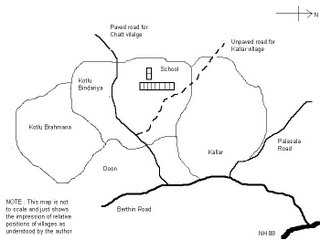Wednesday, July 05, 2006
The Villages

This would give one an idea about the relative location of each village and the school. All these four villages come under one Panchayat (village council). Right now, advocate Mr. R L Bharadwaj is the Pradhan (chief) of the Panchayat. Depending on the population of the village, it may have one or mode wards. Every ward is represented in the Panchayat via an elected representative. Right now, Kallar and Kotlu Bindariya each has one representative, while
Every village has its own Mahila Mandal (women committee), headed by a Pradhan. Typically, these Mahila Mandals take care of women related issues in the villages. They are kind of an evolved version of the earlier concept of self help groups (SHG). In order to encourage increased participation of women in village affairs, government has made this structure mandatory. In lot of cases, these are pretty effective also, as these groups get funding from the government and authority plus responsibility for women affair in the village.
Put together, these four villages have roughly 2000 people, around 400-450 households. Most of the area covered under these villages is sparsely populated, though there are few concentrated pockets as well. Most of the villagers grow wheat and corn as the main crops. In between these two crops and sometimes side by side, they would grow some other stuff just for home consumption purposes. Somehow, villagers out here have not started moving on to other kind of value crops. I still need to figure out the reasons behind this, but right now, I have no clue whatsoever. Though, I have been told that earlier, people used to grow pulses, rice (in a small part) and other fruits out here but later on they stopped due to various reasons. It seems this area has lot of potential to grow naakh (a variety of pear) but people don’t want to grow them as a crop. I have been told that the primary reason for this is the unavailability of market for the produce. While it does sound little absurd considering that
The other day, I witnessed a very interesting thing – I was waiting for a bus at a place, and suddenly I saw 2-3 men walked behind me to the nearest tree (if you want to call it that) and started talking to an old man sitting near by. This was a “tree” of squash with fruits all over it. Somehow, I didn’t notice it earlier. These people selected which fruit they wanted to buy right on the tree and got them plucked and paid for it to the old man. I was amazed to witness the whole thing. This was like buying the freshest vegetable straight from the tree!!!
Water is the main issue here, whether it is for drinking or irrigation. The hilly terrain makes it more difficult to provide adequate and quality water supply. Most of the farmers are solely dependent on rains for irrigation of their crops. So, if rains fail the crops fail; very simple correlation. Unfortunately, since last 2-3 years the rains are dwindling and farmers have seen 3 consecutive crop failures, which is hurting them real bad. Government on its part has done few things, which includes providing lot of hand pumps through out the state, and laying down water pipeline to reach every nook and corner of the state. Though, it sounds good, and actually it is, but the problem is that eventually water supply board is also dependent on rivers (called a khadd here) etc as water source, and when rains fail there is no water in the source also. People generally are dependant on hand pumps for their drinking water. Off late, this is also causing problem, because in lot of places arsenic has been detected in the underground water, which has rendered lot of hand-pumps useless. World Bank and GTZ Group have done few projects in HP to help solve this problem that too with participation from the local community. Hopefully, these efforts will bear fruits in due course of time and water scarcity will not be a major issue.